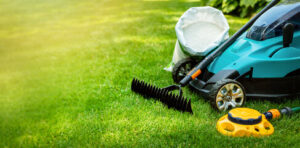Whether you’re hosting a backyard BBQ or watching your children play on the swing set, a healthy lawn enhances the value of your home and creates a beautiful backdrop for special memories. But maintaining a lush lawn takes time and effort.

Using professional-grade products, weed control, soil testing, and regular mowing and watering are essential for keeping your lawn healthy and pristine. Visit https://www.biggreenlawn.com/ to learn more.
Lawn care includes a wide range of tasks that need to be performed on a regular basis in order to keep your lawn healthy and green. These tasks include mowing, aerating, fertilizing, and applying weed control. In addition, mowing the lawn at the proper height is crucial for ensuring that it looks good and stays healthy.
Many people make the mistake of cutting their grass too short, which can actually be detrimental to its health and appearance. In fact, mowing the lawn at a higher height, such as three inches or more, can actually improve its overall health by promoting denser roots and making it more resistant to drought, weeds, and erosion.
A healthy, well-tended lawn can add significantly to your property’s value and help maintain the beauty of your landscape. It can also contribute to a cleaner environment by absorbing carbon dioxide, filtering pollutants from the air, and providing habitat for wildlife. In addition, a healthy lawn can reduce soil erosion, which helps protect the integrity of the surrounding landscape and prevent sediment runoff into waterways.
Whether you’re just starting out or have been taking care of your own lawn for years, there are always new things to learn about this important part of your home’s outdoor living space. From learning the best time to fertilize to the right mowing techniques, this beginner’s guide to lawn care will set you on the path to a beautiful yard.
Before you begin caring for your lawn, it’s a good idea to check over your equipment to make sure that it’s in good working condition. This includes checking the oil, sharpening the blade, and cleaning the cutting deck of your mower. If you plan to use a weed whacker, you should also check its blade and attachments.
When it comes to weeds, you can prevent them from growing by using a pre-emergent herbicide in the spring or post-emergent herbicide in fall. Additionally, aerating the soil and removing plant debris regularly can help contain and control lawn diseases.
Fertilizing
A lush, green lawn has numerous benefits. It adds curb appeal and value to your property, and it also helps filter carbon dioxide from the air, reduces soil erosion, and provides habitat for beneficial insects and wildlife. Lawn care professionals focus on improving soil quality, health, and nutrient availability by conducting regular soil tests to determine the appropriate fertilizer schedule for your turfgrass. They also address issues like watering, mowing, aeration, and weed control to ensure that your turfgrass receives the vital nutrients it needs to thrive.
Fertilizers are natural or synthetic chemical mixtures that contain essential nutrients such as nitrogen (N), phosphorous (P), and potassium (K). All plants require these 17 minerals to grow, but they must obtain them from the soil. The soil feeds the plant by releasing these minerals as it decomposes and breaks down, but the amount of nutrients released varies by location, climate, the living organisms once in the soil, topography, and time. This is why a well-managed lawn requires the occasional application of fertilizer.
A lawn that is nutrient-deficient will experience stress, leading to disease and thinning turf. Diseases such as dollar spot, brown patch, rust, and stripe smut can overwhelm lawns that are not fertilized properly. A healthy, fertilized lawn is better able to resist disease pressure and recover more quickly from environmental stresses such as drought or extreme heat and cold.
When it comes to timing, the best time to apply fertilizer is in the spring after your grass has started to green up but before it begins growing vigorously. This is when the roots are still storing up carbohydrates from last fall to facilitate early spring growth. You should also avoid mowing right after applying fertilizer because this will sacrifice root growth for leaf growth, which will result in a weak and thin lawn.
We recommend a liquid or tonic type of fertilizer for quicker uptake by the turfgrass. Our professionals also aerate your lawn as part of the application process, creating tiny openings in the soil that allow air, water, and essential nutrients to get where they need to be.
Aeration & Dethatching
Aeration and dethatching are essential lawn care tasks that allow grass to breathe and absorb nutrients. Aerating involves perforating the soil with small plugs of earth that helps break up compacted soil, and removing the layer of dead grass and debris known as thatch.
Thatch is a layer of interwoven accumulated dead grass shoots, stems, crowns, and roots that create a barrier between the soil and green grass. A thin layer of thatch is beneficial, but when it gets thicker it suffocates the soil and green grass. Dethatching is the process of reducing thatch buildup, and it can be done with either a rake or mechanical dethatching machine.
Signs of thatch buildup include a spongy feeling underfoot or a dark brown color in the turfgrass. When thatch becomes too thick, it can interfere with microbial activity in the soil and hinder water, air, and nutrient absorption through the root system. Dethatching is typically performed once every few years, but aerating may also be needed before dethatching to break up compacted soil.
Aerating breaks up thatch and soil compaction, and helps the lawn get the water and nutrients it needs to thrive. Aerating also improves soil structure and encourages grass root growth. Grass that is aerated is healthier, stronger, and more resistant to disease.
The best time to aerate is late summer or early fall when the grass is growing most vigorously. To avoid stressing the grass, it is important to mow your lawn a little shorter than normal prior to aerating.
Aeration and dethatching should be done at least once a year for healthy lawns. However, not all lawns need to be dethatched or aerated. Some lawns are more prone to thatch and soil compaction than others, so it is important to evaluate your yard on a regular basis and make decisions based on what is best for your particular situation. We can help you determine if aerating or dethatching is necessary, as well as develop a maintenance schedule for your property. To learn more, contact us today!
Irrigation
Lawn care involves a wide variety of services and practices that nurture grass, soil health, and overall turf condition. These range from mowing and watering to fertilizing and pest control. Healthy lawns add beauty to your property, increase the value of your home, and provide numerous environmental benefits.
Proper lawn care encourages a lush, dense turf that reduces erosion and pollutants, minimizing runoff into waterways. It also provides an enjoyable setting for outdoor recreation and promotes physical activity.
Aerating the soil helps nutrients, water, and oxygen reach the roots of the lawn. This makes it easier for the grass to photosynthesize, which is crucial for its health and vitality. Mowing at the proper height for your grass type, which is determined by a soil test, helps reduce thatch buildup and promotes healthy growth.
Mulching is another important step to help manage the moisture levels of the soil. This prevents soil compaction, allowing the grass to absorb more water and nutrient, reducing the need for frequent watering. Weed control is another important aspect of lawn care because weeds compete with the grass for water, sunlight, and nutrients. Regular weeding with an herbicide ensures that weeds are killed before they become a problem.
The final essential component of lawn care is irrigation. A quality irrigation system takes the guesswork out of watering, delivering the right amount of water to each area in the yard at the right time. There are several different types of irrigation systems, ranging from a drip system that delivers water directly to the root zone of each plant or shrub to spray irrigation that distributes water in a fan-like pattern for uniform coverage.
With water rates on the rise across south Ontario, a quality irrigation system can save both time and money while ensuring your plants are properly hydrated.
In general, it’s best to irrigate in the morning rather than the evening. This gives the soil a chance to fully absorb the water before the sun sets and evaporates, reducing water waste. A good rule of thumb is to irrigate until the soil is moist 6 inches down, which should be enough to avoid “footprinting” or wilting in most situations.
